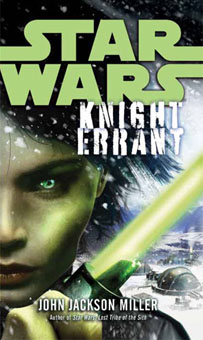Isaac Asimov’s “Foundation” books don’t get mentioned enough as influences on “Star Wars.” In addition to inventing a planet named Korellia, only one letter off from Han Solo’s home world of Corellia, Asimov outlined interplanetary politics over the course of millennia in humans’ future in the Galactic Empire.
The notable difference, of course, is that — although the books are very readable — the seven “Foundation” novels play like a broad, millennia-spanning history, whereas the “Star Wars” novels are adventure yarns, each one of which takes place in a short period of time.
Still, John Jackson Miller’s “Knight Errant” (2011, Del Rey paperback) calls to mind the “Foundation” series on a smaller scale. Set 1,032 years before “A New Hope” and just a generation before Darth Bane whittled the Sith Order down to two people, “Knight Errant” takes place in the Sith portion of the “Star Wars” universe.
At this time, it is separated from the Old Republic, which due to economic and other factors, is essentially curled up in a fetal position around the Core worlds. So when our hero, Jedi Kerra Holt, gets stranded in Sith territory after a botched mission, she is cut off from any contact — let alone hope of backup or rescue — from the Jedi Council or the Republic.
That would seemingly lend itself to a dark exploration of Kerra’s loneliness and meager survival, but “Knight Errant” — which spins off from a Dark Horse comic book of the same name, although the novel stands alone — isn’t a depressing read. Miller pulled off a similar trick in his “Knights of the Old Republic” comic series, which followed a wrongly exiled Jedi and his merry gang of mercenaries, misfits and outcasts (Think “Firefly”).
Kerra quite doesn’t acquire a gang of her own here; I hope she will in future books. Still, there are decent side characters like mercenary brigadier Rusher and Bothan spy Narsk. The real pleasure is in exploring the Sith sector — a nice place to read about, but you wouldn’t want to live there — as Kerra tries to find a suitable world to dump off more than a thousand young refugees traveling on Rusher’s ship.
Remember those maps of old Germany from your high school history class, and the way it was broken up into dozens of feudal states? That’s Miller’s vision of Sith territory. First we enter into a war between brothers — Daiman, who believes he created the universe, and Odion, who wants to destroy everything. Then we visit a world where the Sith Lord controls everyone’s minds. And finally we stop off at a planet where everyone seems happy — at first glance.
And furthering the “Foundation” parallel, we ultimately find out that this is more of a people-based story than the historic travelogue of our initial impressions.
“Knight Errant” is still too broad for me to label it a great character piece; Miller will need more comic issues and more novels to accomplish that, and I hope he gets the opportunity. For now, Kerra, although her circumstances are unique, is a rather generic Jedi (So if you came for a climactic lightsaber fight, you’ll get it). The real accomplishment of “Knight Errant” is how Miller delves into how exactly these short-lived Sith governments functioned — which in turn shows why they were so short-lived.

As a “Star Wars” novel, “Knight Errant” is middle-of-the-road. Completists will enjoy it and forget it; casual or discerning fans can probably skip it.

